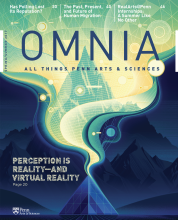Lauren Sallan does not shy away from a challenge.
Since arriving at Penn in 2014, Sallan, a paleobiologist and Martin Meyerson Assistant Professor in Interdisciplinary Studies, has questioned, and in some cases overturned, closely held tenets of paleontology. Using big data analytics and new approaches to the study of fossils informed by living biology, her findings are reshaping our understanding of how global events, environmental change, and ecological interactions shaped evolution and modern biodiversity.
Sallan’s unique take on her field recently earned her a spot in the 2017 class of TED Fellows, a group of 15 young innovators from the around the world. She delivered a talk on the TED stage this April in Vancouver.
“The TED Talk was an amazing opportunity to share what fossil data tells us about the rules of biodiversity with a global audience,” Sallan says.
Sallan’s interest in fossils, specifically in fish, began in childhood, growing up just outside Chicago with its world-famous Field Museum and Shedd Aquarium. In her doctoral work at the University of Chicago and a fellowship position at the University of Michigan, she developed a macroevolutionary approach to her studies, examining ecological and morphological changes that occurred over long time periods. To do so, she’s plumbed the depths of fossil collections worldwide to compile massive databases, from which she has deciphered telling patterns.
“The TED Talk was an amazing opportunity to share what fossil data tells us about the rules of biodiversity with a global audience.”
The Rise of the Tiny
One of Sallan’s biggest splashes came in the fall of 2015. She mentored Andrew K. Galimberti, then an undergraduate at Kalamazoo University and now a graduate student at the University of Maine, in order to amass a huge dataset of the body sizes of 1,120 fish fossils spanning the period from 419 to 323 million years ago.
They were interested in finding out how body sizes changed following a mass extinction 359 million years ago known as the Hangenberg event, which decimated life on the planet. More than 97 percent of vertebrate species—which at that time were all water-dwelling—were wiped out.
Paleontologists and evolutionary biologists have long debated the reasons behind changes in animal body sizes. One of the main theories is known as Cope’s rule, named after 19th century Penn professor and alumnus Edward Drinker Cope, most famous for his participation in the “Bone Wars,” a scientific rivalry over dinosaur specimens. Cope’s rule states that the body size of a particular group of species tends to increase over time because of the evolutionary advantages of being larger, such as avoiding predation and being better able to catch prey.
Other theories suggest that animals tend to be larger in the presence of increased oxygen, or in colder climates.
Still another idea, known as the Lilliput Effect, holds that after mass extinctions, there is a temporary trend toward small body size. But this theory has only been supported with a limited number of species and is highly debated.
Sallan and Galimberti’s analysis of these fossils revealed that, in line with Cope’s rule, vertebrates gradually increased in size during the environmentally stable Devonian Period, from 419 to 359 million years ago.
By the end of the Devonian, “there were fish called arthrodire placoderms with large slashing jaws that were the size of school buses, and there were relatives of living tetrapods, or land-dwelling vertebrates, that were almost as large,” Sallan says.
Then came the mass extinction. Reporting their findings in the journal Science, the researchers showed that the Hangenberg event triggered a drastic and lasting transformation of Earth’s vertebrate community. For at least 40 million years following the die-off, the oceans were dominated by markedly smaller fish.
“Rather than having this thriving ecosystem of large things, you may have one gigantic relict, but otherwise everything is the size of a sardine,” says Sallan.
The findings, which suggest that small, fast-reproducing fish possessed an evolutionary advantage over larger animals in the disturbed, post-extinction environment, mirrors what ecologists can observe in opportunistic plants following short-term disasters, such as forest fires. Thus, life histories and survival strategies linked to size, rather than the benefits of being large or climate change, are the key to long-term evolutionary size trends like Cope’s rule. This may have implications for the future of modern species, such as fish populations, many of which are crashing due to overfishing.
“It doesn’t matter what is eliminating large fishes or what is making ecosystems unstable,” she says. “These disturbances are shifting natural selection so that smaller, faster-reproducing fish are more likely to keep going, and it could take a really long time to get those bigger fish back in any sizable way.”
New Perspectives
Other recent studies out of Sallan’s lab have similarly challenged textbook ideas of evolutionary biology and paleontology, leading to new perspectives on modern diversity. In a publication in the journal Current Biology in 2016, for example, Sallan examined an unusual set of 350-million-year-old fish hatchling fossils from the genus Aetheretmon. Experts from Thomas Huxley (known as Darwin’s bulldog) to Stephen Jay Gould had proposed that an ancient, scaly tail appeared in embryos of living teleosts, a group of ray-finned fish that make up more than 95 percent of living fish species, and then became locked within the flexible fins of adults. This became the textbook example of evolution repeated in development, or recapitulation. But fossil data were lacking.
“Disturbances are shifting natural selection so that smaller, faster-reproducing fish are more likely to keep going, and it could take a really long time to get those bigger fish back in any sizable way.”
Sallan showed that ancient juvenile fish had both a scaly, fleshy tail and a modern, flexible fin, one sitting atop the other. A similar dual-tail structure is seen in the embryos of modern teleosts. Over evolutionary time, to adapt to their environments, Sallan realized, adult teleosts kept their fins and lost their tails, while tetrapods did the opposite.
“All vertebrate tail diversity might be explained by the relative growth and loss of these two tails, with the remaining fleshy tail stunted in humans as in fishes," Sallan says.
Unlike many paleontology findings, Sallan says this one might be proved in a modern molecular biology laboratory, as it’s likely that the two outgrowths are governed by two groups of genes. A developmental biologist might be able to determine the actual molecular pathways that generate tail growth or fin placement.
Earlier this year, Sallan engaged in a “settled” paleontological debate, challenging two studies that were published last year in Nature about the odd, ancient “Tully monster,” Tullimonstrum gregarium, which lived more than 300 million years ago. Those studies had claimed to have resolved a decades-old paleontological mystery about the identity of the Tully monster. Rather than it being a worm or a mollusk, as previous studies had suggested, the Tully monster was, according to the new studies, a vertebrate, probably related to a type of jawless fish called a lamprey.
But that claim rubbed Sallan the wrong way.
“This animal doesn't fit easy classification because it’s so weird,” says Sallan “It has these eyes that are on stalks and it has this pincer at the end of a long proboscis and there's even disagreement about which way is up. But the last thing that the Tully monster could be is a fish.”
Together with colleagues, Sallan dove into the Tully monster debate with a publication in the journal Palaeontology. While the authors of one of the earlier studies determined that they could identify internal organs characteristic of vertebrates from Tully monster fossils, Sallan and colleagues noted that these conclusions are based on a misunderstanding of how fossils in the region are preserved.
“In the marine rocks [where the Tully monster specimens were found], you just see soft tissues; you don’t see much internal structure preserved,” Sallan says.
The other previously published study examined the organisms’ eyes with a scanning electron microscope, reporting the presence of complex structures akin to those of vertebrates.
Yet species besides vertebrates, such as arthropods and cephalopods like octopuses, also have complex eyes, Sallan says.
What’s more, the team noted that none of the more than 1,000 Tully specimens examined appeared to possess structures that are believed to be universal in aquatic vertebrates, notably otic capsules, components of the ear that allow animals to balance, and a lateral line, a sensory structure that enables fishes to orient themselves in space.
“You would expect at least a handful of the specimens to have preserved these structures,” Sallan says. “Not only does this creature have things that should not be preserved in vertebrates, it doesn’t have things that absolutely should be preserved.”
The researchers said that an improper classification of such an unusual species has ripple effects on the larger field of evolution.
“Having this kind of misassignment really affects our understanding of vertebrate evolution and vertebrate diversity at this given time,” Sallan says. “If you’re going to make extraordinary claims, you need extraordinary evidence.”
Past Is Prologue
Sallan is hoping to continue unearthing her own extraordinary evidence, both by looking closely at individual fossils, and also by assessing global and long-term trends with large sets of fossil data. She says it’s not a huge leap to draw conclusions about how creatures may respond to ecosystem changes, from overfishing to habitat destruction to climate change to invasive species, based on how they responded to similar changes multiple times over the last hundreds of millions of years.
“Of course today we have a lot of anthropomorphic pressures that creatures didn’t face in prehistoric times,” Sallan says. “But what we learn from the fossil record may help us predict what biodiversity will look like in the future.”








